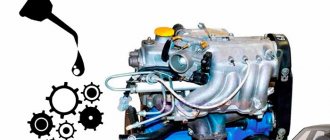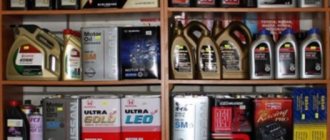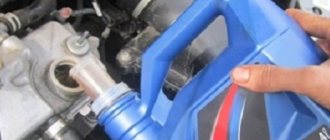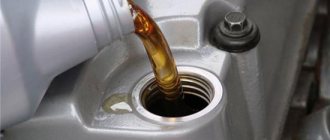- home
- Brands
- VAZ
01.09.2020
VAZ-2107 is a rear-wheel drive sedan from the classic AvtoVAZ family, produced from 1982 to 2014. It is a modernized version of the VAZ-2101, 2102 and 2103 cars. The development project for this model began in the early 70s with the aim of updating the outdated model family with the Fiat 124 design. As a result, AvtoVAZ released a whole family of cars, including the 2107 and the 2104 station wagon. Sedan 2107 is considered to be a redesigned VAZ-2105, which was produced in parallel with the “Seven”. The car was exported under different designations: Lada 1500, Signet, Riva and Nova. The successor to the VAZ-2107 in 2012 was the Lada Granta.
Oil change period in the VAZ 2107 engine
The period for changing the oil in the engine of a VAZ-2107 car is one year or every 10 thousand km. This procedure may be required much earlier if the following signs of low-quality oil are detected: cloudiness, a burning smell, the presence of wear products (in the form of sediment) or a decrease in the fluid level. As a rule, oil becomes unusable faster during sudden starts and braking in city traffic jams, with frequent driving on a dusty country road, etc. It must be borne in mind that any (even original) lubricant begins to lose its beneficial properties after 7-8 thousand km, but in harsh conditions, after 6 thousand km these useful additives can have a more negative rather than a positive effect on the engine.
Oil filter device
The non-separable filter used on “classic” VAZ models is a stamped cylindrical element, on which edges are provided for a chain or ring wrench. Inside there is a filter cartridge made of paper, which is held in place by a lid. Oil is supplied through a valve that prevents the discharge of contaminated lubricant into the crankcase. The filter is screwed onto a threaded fitting and has a rubber O-ring. The cleaning element is changed when fresh lubricant is poured into the engine sump.
An oil filter is a special device designed to clean oil from solid particles.
How much oil to pour into the VAZ 2107 engine
First generation 2107, 1982-2013
Unlike the “five,” model 2107 was equipped with a more modern 77-horsepower 1.5-liter engine, as well as an improved exterior and interior. Thus, the car received a new radiator grille in the style of old Mercedes, as well as original taillights, new front seats and a front panel with tachometers. Some interior trim elements have changed. In 2008, a version appeared with a 73-horsepower 1.5-liter engine, which had distributed injection. Total production of the 2107 was 3.1 million units.
Also read: Motor oil for Nissan Juke engine
Gasoline engines 1982-2012
- 1.3 64 l. With. (2105), oil volume - 3.75 liters, tolerance and viscosity: API-SG, SJ, SL, SM; SAE 5W-40, 10W-40, 10W-30, 5W-30, 0W-40, 0W-30, 20W-40
- 1.5 68 l. With. (2103), oil volume - 3.75 liters, tolerance and viscosity: API-SG, SJ, SL, SM; SAE 5W-40, 10W-40, 10W-30, 5W-30, 0W-40, 0W-30, 20W-40
- 1.5 72 l. With. (2103), oil volume - 3.75 liters, tolerance and viscosity: API-SG, SJ, SL, SM; SAE 5W-40, 10W-40, 10W-30, 5W-30, 0W-40, 0W-30, 20W-40
- 1.6 73 l. With. (2106-20), oil volume - 3.75 liters, tolerance and viscosity: API-SG, SJ, SL, SM; SAE 5W-40, 10W-40, 10W-30, 5W-30, 0W-40, 0W-30, 20W-40
- 1.6 74 l. With. (21067), oil volume - 3.75 liters, tolerance and viscosity: API-SG, SJ, SL, SM; SAE 5W-40, 10W-40, 10W-30, 5W-30, 0W-40, 0W-30, 20W-40
- 1.6 75 l. With. (2106), oil volume - 3.75 liters, tolerance and viscosity: API-SG, SJ, SL, SM; SAE 5W-40, 10W-40, 10W-30, 5W-30, 0W-40, 0W-30, 20W-40
- 1.7 79 l. With. (21213), oil volume - 3.75 liters, tolerance and viscosity: API-SG, SJ, SL, SM; SAE 5W-40, 10W-40, 10W-30, 5W-30, 0W-40, 0W-30, 20W-40
For injection system
Forced fuel supply in the "seven" for the Russian market began to be used in 2006. In these car models, the fan operation and other functions are performed by the ECU. On the VAZ 2107 injector, the signal about the antifreeze temperature comes from the coolant temperature sensor, which is located on the right side of the engine cylinder block.
The data is processed by the ECU, which outputs a signal to the control relay to turn on the cooling - circuit diagram. The fan switching sensor is not needed on VAZ 2107 injection systems; it is replaced by a thermistor sensor, and control functions are assigned to the controller.
In any “seven”, to protect the fan from short circuit, there is a fuse F7 located in the mounting block.
Operation of the coolant temperature sensor for the injection system
Usually, turning on the fan on a VAZ 2107 is accompanied by a noise that the driver hears while sitting behind the wheel. A prolonged absence of sound from the device when driving around the city in the summer may indicate a malfunction in the cooling system, which can lead to antifreeze boiling and damage to engine components. The driver must react quickly to such defects so as not to spoil the “heart” of his car.
One of the possible malfunctions in the engine cooling cycle may be a breakdown of the coolant temperature sensor. In addition to the cooling system, it is responsible for the correct supply of the air-fuel mixture to the engine and its inclusion in idle mode.
The sensor that affects the operation of the VAZ 2107 injector fan consists of a semiconductor thermistor with two terminals, soldered into a housing with a thread that is screwed into the wall of the cylinder block. A constant voltage of 5 V is supplied to the device. As the temperature of the antifreeze increases, the resistance of the thermistor decreases and vice versa. At the input to the computer, passing through a resistor, the voltage drops as the coolant temperature increases to a certain level, after which the controller gives a signal to turn on the cooling.
How to check and install a new one
Checking the sensor responsible for turning on the fan does not require much effort. The following signs may serve as grounds for verification:
- The “Check Engine” light on the instrument panel is on.
- The fan operates continuously or is turned off.
- Low idle torque.
- Coolant overheating.
The cause of the malfunction may be outdated wiring. To find out for sure, you need to check it, and then move on to the sensor.
For this:
- The negative cable of the battery is disconnected.
- On a cold engine, the antifreeze drains to a level below the temperature sensor socket.
- The protective layer is shifted and the wiring from the temperature sensor is disconnected.
- Use a key to unscrew the sensor from its socket.
Next, check using a multimeter and boiled water. The multimeter is connected to the outputs of the temperature sensor and set to resistance measurement mode. The threaded side is placed in boiling water. If the resistance tends to zero, then the sensor is working. Otherwise, if increased resistance readings appear, the sensor requires replacement.
To replace it, it is better to purchase the same model that was installed when purchasing the car. Installation of a new sensor occurs similarly in the opposite direction.
What oil to use for the VAZ 2107 engine
Original
VAZ-2107 owners prefer mainly semi-synthetic oil, but you can also choose more expensive semi-synthetic or synthetic oil of varying viscosity, which is selected depending on temperature conditions. For example, for year-round operation, a 10W-40, 10W-30 or 5W-40 all-season oil is recommended. In the winter season, it is better to fill in 0W-30, 0W-40 or 5W-30, and in the summer you can opt for 20W-40 or 25W-50.
Unoriginal
Owners of VAZ-2107 cars prefer inexpensive motor oils from domestic brands Lukoil, Rosneft, G-Energy and Gazpromneft. When choosing a suitable product, it is necessary to take into account the API approval, which is selected depending on the year of manufacture of the car, as well as the type of internal combustion engine. For example, for a gasoline VAZ-2107 manufactured in 1982. All-season mineral oil with parameters 15W-20 and API-SG is suitable. For 2013 model year vehicles, pure synthetic API-SM is recommended. Below are the best options for analogue motor oils for the VAZ-2107.
- ZIC X5 10W-40
- Lukoil Lux 10W-40
- Mobil Super 3000 5W-40
- G-Energy 10W-40
- Eneos 10W-40.
Also read: Motor oil for Honda Stream engine
Types of oil
- Synthetic is the thinnest oil. Due to its fluidity, such a liquid is very resistant to low temperatures and never freezes in cold weather. Recommended for new cars, including VAZ-2107 with low mileage.
- Mineral oil is the cheapest and thickest oil. Perhaps these are all its advantages. Not suitable for low temperatures, but it will be the best option for cars with high mileage.
- Semi-synthetic is a cheaper oil than pure synthetics. But at the same time, its advantages pale in comparison to real synthetic oil. And yet, semi-synthetic is definitely better than mineral oil. Considering the fact that the car is cheap, this oil is suitable for it.
Check and replacement
If you suspect that the engine is overheating and there is no sound from the fan for a long time, it is necessary to determine the malfunction. If the wiring is shorted, the device may fail or the fuse may blow.
Checking the device is easy. You need to remove the wiring from the sensor, turn on the ignition key and connect the ends. If the cooling works, then there is a problem with the device and it needs to be replaced. It happens that cooling turns on at temperatures higher than those indicated on the sensor body, which also indicates its malfunction.
To replace it, you will need to drain the antifreeze or rush to screw in a new sensor, spilling a little coolant. The engine must be cold. You can unscrew it with a wrench or an adjustable wrench. It is better to substitute some kind of container and use a wrench to undermine the housing nut. Then carefully unscrew the thread by hand, pressing it against the socket. Move the old device aside and quickly press it with your finger, maybe some kind of plug, on the hole in the radiator. Carefully screw in the purchased sensor and connect the wiring.
Preparing for replacement
Many people advise replacing the lubricant when the power unit is warm. When the operating temperature of the power unit is reached, the lubricant acquires its initial fluidity characteristics. When flushing the engine, you need to pour a special liquid into it and let the unit run at idle speed for 10 minutes.
Before replacing the material, you should prepare a number of tools:
- the oil itself;
- an oil filter that meets the factory specifications of the power plant;
- a set of keys;
- a container where waste material will be drained;
- rags for wiping.
Replacement of gas tank and major repairs
Regardless of what type of fuel injection is used on your vehicle, the process for removing the tank will be the same. First drain all fuel from it. Next, carry out the following work:
- Remove the plastic casing from the container. To do this, you will need to unscrew several screws using a Phillips screwdriver.
- Disconnect the wires from the contacts leading to the fuel sensor.
- Use pliers to pry off the fuel hose.
- Unscrew the bolt of the tension plate that secures the gas tank.
- Remove the cap from the neck and carefully remove the tank.
Assess its condition. If there are several leaks or they are too large, then it will be easier to replace the entire fuel container. To do this, simply take a new tank and reassemble it in the reverse order.
If you do not have the opportunity to buy a new container, then stock up on:
- fiberglass;
- epoxy resin;
- acetone;
- sanding paper.








